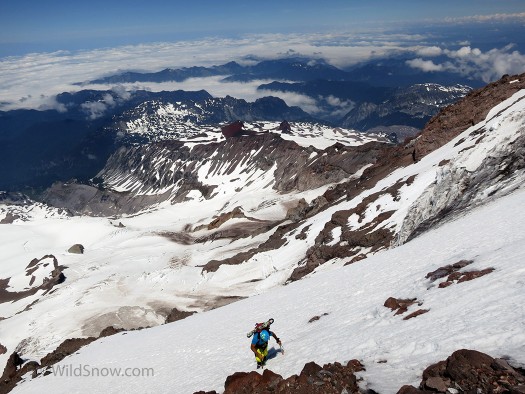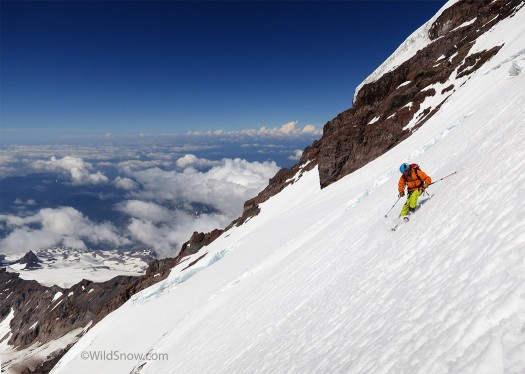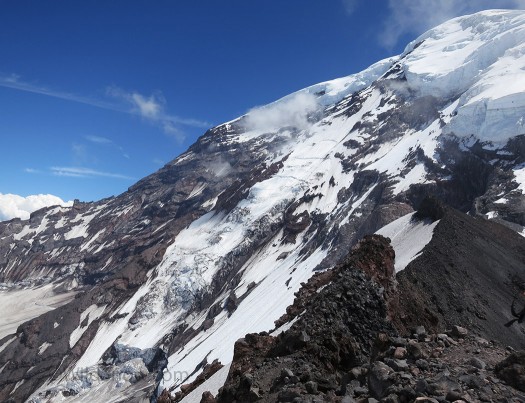(Editor’s note: We just heard about an individual who was hurt or killed from a fall down Edmunds Headwall. Pure coincidence that we’d post this today. We wish the best to anyone involved and will edit this for accuracy once we know the details.)
It’s getting to be that time of year. I’m starting to feel the pull of warm summer rock. However, there’s still skiing to be had. I can’t resist.
I’ve neglected Rainier for the years I’ve lived in the northwest. Rainier is difficult, and the upper mountain seems to rarely hold good snow. Also, the National Park status is a big turnoff with it’s barrage of regulations, permits, and closures (even if only because I’m lazy). However, the lofty volcano entices anyone who enjoys skiing big lines — including me.
Speaking of regulations, a brief sidenote: Last week one of my co-workers, a distinctly non-outdoorsy guy, told me he wanted to go camping over the weekend, maybe even backpacking. I helped him out with some trip and gear questions, and also let him know that he should be sure to get the right pass for where he decides to go.
In Washington we have an truckload of potential passes and permits required for outdoor recreation. The various National Parks each have their own systems, usually separate permits for parking, hiking, climbing, and camping. A specific pass is required for parking at all state parks, and another for National Forest trailheads. There are even a few more specific ones scattered around the state. The piddly cost isn’t much of an issue, but keeping track of all of them can be a headache. Forget spontaneity, you need to plan in advance, figure out what you need, and where you can buy it.
A few days later, my friend told me that after going through various government websites and phone-trees, he’d given up on figuring out where to go and what kind of pass to get. Granted, I don’t think he was very motivated, and didn’t put much effort forward. However, I thought it was interesting, and a little sad, that he was deterred from enjoying our outdoors by the very systems and agencies that are mandated to protect them.
Ok, rant over.
The Northwest side of Rainier (as seen from the Puget Sound area), is impressively steep. There’s several worthy ski lines, and no easy way up, or down. Hoping to take advantage of warm temps and avoid 4th of July crowds, we decided to give it a try.
Adam, Russel, and I headed out of town Friday morning. The drive from Seattle is short. Still, someone forgot to fill up the gas tank. By the time we noticed we were already far past the last gas station. We arrived at the trailhead on fumes, and quickly started the hike up to Ptarmigan ridge. The walk to camp went well, albeit we did encounter a bit of darkness due to our late start.
Our “morning” alarm came to soon. At 2am, we shoveled breakfast into grumbling stomachs and headed farther up the ridge. Edmunds Headwall, our objective, lies at the top of the Edmunds Glacier, which itself lies about 1500 feet below our camp. We found a cliff-free area of the scree slope separating the two and began to descend. Among the vile terrain type known as scree, the volcanic variety stands in a crumbly, chossy class of its own. In the dim early morning light we slid and stumbled down the pile of shattered dinner plates to the blissfully solid snow below. Now we could start the climb.
We made short work of the lower glacier, but still arrived a the base of the climb a little late, around 9 am. We haven’t had many storms this June, and the route was looking melted out. The bergschrund was completely impassable but we found a way around through broken crevasses on the left.
The snow on the face wasn’t the perfect corn we had hoped. We could see patches of blue ice around us, and telltale shiny spots on the upper slopes. Russel wasn’t liking the snow quality and decided to nap in the sun while Adam and I continued upward. I was tempted to join him.

As we climbed, clouds seemed to cover the rest of the world, one of my favorite little treats of skiing volcanoes.
The climbing was fun, we even encountered a few hundred feet of solid, blue, alpine ice. The steep, precarious climbing was exhilarating. Even with the ice, we thought we could find a way down that stuck to rip-able snow. We reached the top of the headwall proper, at a flat bench around 12,500 feet.
On the climb we encountered big stretches of snow that was inches deep, on top of hard alpine ice. From experience, I knew snow like that is skiable enough, until it gets to soft, and your skis sink down to the icy layer. The ice of course will never soften in the sun. At that point, things get a bit more exciting. Wanting to avoid such excitement, we opted to ski before the snow softened to much. I was a little disappointed to not have made it to the top of the line, but I was psyched for the descent.
The skiing wasn’t corn, but it was fun. Steep, exposed, with incredible views. We leapfroged down the face toward the enticing corn on the Edmunds Glacier. We hit the nieve perfectly, and found wonderful, smooth corn. We pushed the speed limit, took a nap on some warm rocks, and then headed back to the kitty liter pile protecting camp. I was out of food and eager to get back, so I pushed ahead as Russel and Adam took a more leisurely pace. I stuck to as much snow as I could, until the only choice was to venture out into the sea of choss. With every step, an entire section of the slope moved, but a thigh-burning, half-running ascent, I was at the top. I hung out a bit, then headed down to camp.
After a few hours of snacking an napping it was dark, and my partners still hadn’t shown up. It would have been all to easy to get hurt on the scree, so I was worried. Just as I was mustering the strength to get out of my sleeping bag and look for them, I heard their voices. They had chosen a different route that turned out to be much more of an adventure. Rock climbing up vertical cliffs of choss, in the dark, they’d dodged numerous boulders but emerged unscathed.
The next morning we slept in late, and headed up the Russel glacier, near camp. At the top we got a good look at Liberty Ridge (also pretty melted out), and then skied fast corn back to camp.
We packed up and made our way to the trailhead, prepared to deal with our empty gas tank. Just as we had hoped, the road back was sufficiently steep; we turned off the engine and coasted for a good 20-30 miles. A few times we had to get out and push, but in the end we made it back to the welcome fluorescent lights of a fuel stop.
Louie Dawson earned his Bachelor Degree in Industrial Design from Western Washington University in 2014. When he’s not skiing Mount Baker or somewhere equally as snowy, he’s thinking about new products to make ski mountaineering more fun and safe.







